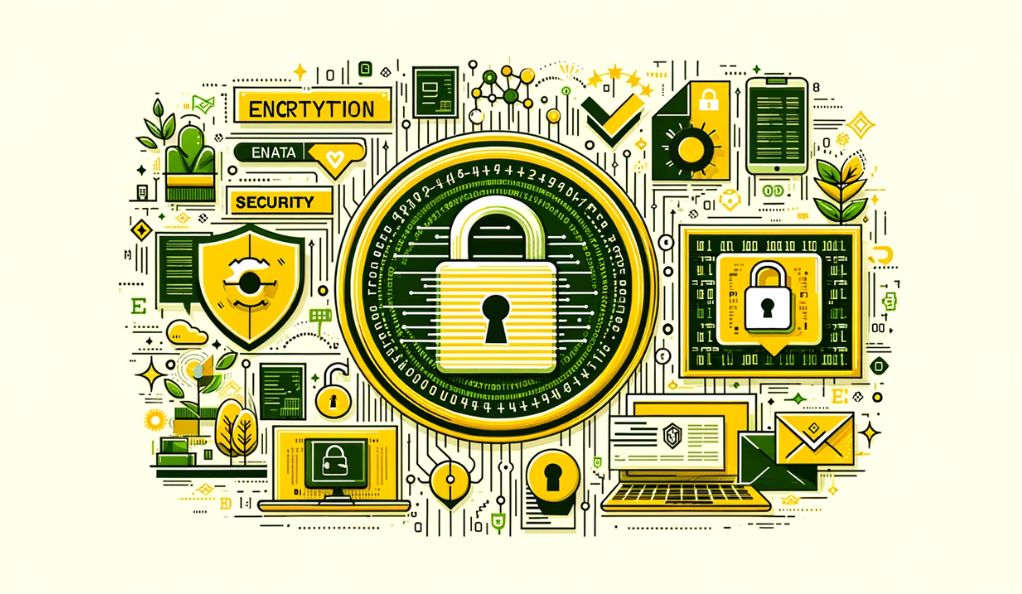Introduction to Data Encryption
In the digital era, where data breaches and cyber threats loom large, securing online presence is not just a choice but a necessity. At the heart of this security lies data encryption, a powerful tool in the armory against cyber threats. This section delves into the essence of data encryption, its pivotal role in safeguarding digital information, and introduces the key types of encryption methods prevalent today.

The Significance of Data Encryption
Data encryption is the process of converting information or data into a code, especially to prevent unauthorized access. This cryptographic method masks the original data, making it unintelligible to anyone who does not have the key to decode it. In a world where digital transactions and communications form the backbone of both personal and business activities, encryption acts as a critical barrier against data theft, eavesdropping, and other forms of cybercrime.
Types of Encryption Methods
- AES Encryption (Advanced Encryption Standard):
- Used in various applications like file encryption, wireless security, and cloud security protocols.
- Known for its robustness and speed, AES is a symmetric key encryption algorithm, meaning the same key is used for both encrypting and decrypting data.
- RSA Encryption (Rivest-Shamir-Adleman):
- A type of asymmetric encryption, requiring both a private and public key.
- Ideal for secure data transmission, RSA is often used in digital certificates and secure email communications.
- Blowfish Encryption:
- A symmetric block cipher that provides strong encryption without the patent restrictions.
- Known for its versatility and efficiency in encrypting large amounts of data.
Each of these encryption methods has its unique characteristics and applications, making them suitable for different types of data protection needs. While AES is praised for its speed and security, RSA is renowned for secure data transmission, and Blowfish offers a good balance between speed and security for bulk data encryption.
Understanding Encryption Keys
Encryption keys are the cornerstone of data encryption, serving as the critical tool for both encoding and decoding information. These keys come in different forms and are used in various encryption methods. Understanding their types and functionalities is crucial for effectively implementing encryption strategies.
- Symmetric Keys:
- Symmetric key encryption involves a single key for both encryption and decryption processes.
- This key must be kept secret and shared only among authorized parties.
- AES, one of the most widely used encryption methods, employs symmetric keys.
- Symmetric key encryption is typically faster and more efficient, making it suitable for encrypting large volumes of data.
- Asymmetric Keys:
- Asymmetric encryption, also known as public-key cryptography, involves a pair of keys: a public key and a private key.
- The public key is shared openly to encrypt data, while the private key is kept secret and used for decryption.
- RSA encryption is a classic example of asymmetric key usage.
- This type of encryption is commonly used for secure data transmission, particularly over the internet.
- Key Management and Security:
- Effective key management is vital to ensure the security of the encrypted data.
- Key management includes the generation, storage, distribution, and destruction of keys.
- Companies must have policies in place to handle keys securely, such as using key vaults or key management services.
- Regularly updating and rotating keys can further enhance security.
Encryption keys play a dual role in safeguarding data and allowing legitimate access. While symmetric keys are preferred for their speed and efficiency in handling large data sets, asymmetric keys are essential for secure data exchange over insecure channels. Proper management of these keys is a critical aspect of a robust encryption strategy, as the strength of encryption lies not just in the algorithm but also in the secure handling of the keys.
Implementing Encryption in Daily Online Activities
The implementation of encryption in our daily online activities is a critical step in securing personal and business communications and data transfers. Here we explore practical ways to incorporate encryption into everyday digital interactions.
| Activity | Description | Tools/Methods |
|---|---|---|
| File Encryption | Encrypting files and drives containing sensitive information. | VeraCrypt, BitLocker, File encryption software |
| Email Encryption | Protecting sensitive email communications. | ProtonMail, Mailvelope, TLS (for service-based encryption) |
| Encrypted Messaging Apps | Securing daily communications through messaging apps. | WhatsApp, Signal, Telegram |
| Disk Encryption | Encrypting entire disks of computers or external drives. | BitLocker (Windows), FileVault (Mac) |
| Secure Web Browsing | Ensuring data exchange with websites is encrypted. | HTTPS (padlock symbol in address bar) |
| VPN Services | Encrypting internet traffic, especially on public networks. | Reliable VPN service providers |
This table outlines key areas where encryption can be applied in everyday digital interactions, enhancing the overall security of personal and business data. It provides an overview of the types of activities that benefit from encryption and the tools or methods commonly used for each. The next section of the article will explore the best practices for encrypting data in the cloud, another crucial aspect of maintaining data security in the modern digital landscape.

Encryption Best Practices for Cloud Data
As more data moves to cloud-based storage and services, implementing robust encryption practices becomes crucial for maintaining data security and privacy. Here are key strategies to ensure effective encryption of cloud data:
- Choose a Secure Cloud Service Provider:
- Opt for providers that offer strong encryption for data at rest and in transit.
- Ensure they comply with relevant security standards and regulations, such as ISO 27001, HIPAA, and PCI DSS.
- Understand the Shared Responsibility Model:
- In cloud services, security is a shared responsibility between the provider and the user.
- While the provider secures the infrastructure, users are responsible for protecting their data within that infrastructure.
- Implement Strong Authentication:
- Use robust authentication methods like multi-factor authentication (MFA) to control access to cloud data.
- Consider passwordless technologies for added security.
- Encrypt Data at Rest and in Transit:
- Use tools and services that provide encryption for stored data (data at rest) and data being transmitted (data in transit).
- For instance, Azure Storage Service Encryption and Azure Disk Encryption are effective for data at rest.
- Manage Encryption Keys Effectively:
- Use key management services to securely store and manage encryption keys.
- Regularly update and rotate keys to prevent unauthorized access.
- Protect Data Across All Locations:
- Ensure data is encrypted not just in the cloud but also when it is downloaded or used on local devices.
- Apply end-to-end encryption to safeguard data throughout its lifecycle.
- Monitor and Audit Access:
- Regularly review access logs and monitor for any unauthorized attempts to access encrypted data.
- Implement auditing and reporting tools to track compliance and detect potential breaches.
Tools and Software for Enhanced Data Encryption
The effectiveness of data encryption largely depends on the tools and software used. Here is an overview of various encryption tools and software, each serving different purposes in the realm of data security:
- Password Managers:
- Tools like Bitwarden and LastPass store and manage complex passwords, often with their own encryption layers, enhancing security across various platforms.
- Encryption Software for Files and Drives:
- VeraCrypt and BitLocker are popular for encrypting files and entire drives, providing robust security for data at rest.
- Email Encryption Tools:
- Services like ProtonMail offer end-to-end email encryption.
- Plugins like Mailvelope can be added to existing email services for additional encryption capabilities.
- Secure Communication Apps:
- Apps like Signal and WhatsApp provide end-to-end encryption for messaging, ensuring that communication remains private.
- Cloud Encryption Tools:
- Tools specifically designed for cloud data, like Boxcryptor, encrypt files before they are uploaded to cloud services.
- Many cloud service providers also offer built-in encryption features for data at rest and in transit.
- VPN Services:
- VPNs like NordVPN and ExpressVPN encrypt internet traffic, protecting data in transit, especially on public Wi-Fi networks.
- Encryption Key Management:
- Services like Azure Key Vault and AWS Key Management Service help securely store and manage encryption keys.
- Data Loss Prevention (DLP) Software:
- Tools like Microsoft Purview and Symantec DLP provide capabilities to identify, monitor, and protect data across various platforms.
- Browser Extensions for Secure Browsing:
- Extensions like HTTPS Everywhere ensure that connections to websites are encrypted where possible.
Choosing the right encryption tool or software depends on specific needs, such as the type of data being protected, the platform it resides on, and the level of security required. It’s crucial to select tools that are reputable and align with current encryption standards to ensure maximum security.
Conclusion
In conclusion, securing our online presence through data encryption is not just a protective measure but a necessity in the digital age. From understanding encryption keys to implementing them in daily online activities, and choosing the right tools for cloud data security, this guide has provided comprehensive insights into the world of data encryption. As cyber threats evolve, staying informed and adapting to the latest encryption technologies and best practices is crucial for safeguarding our digital lives now and in the future.








